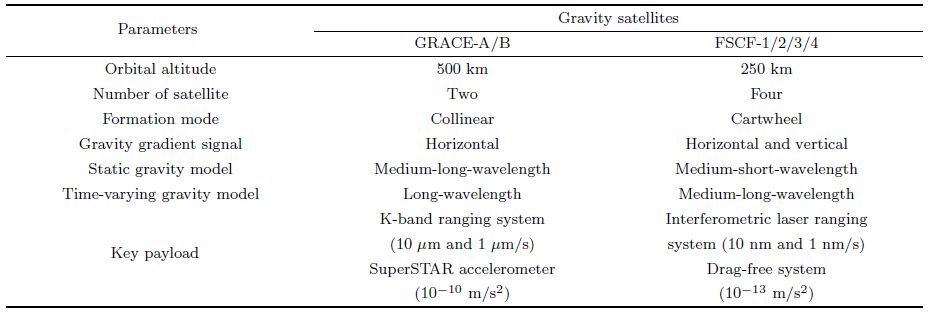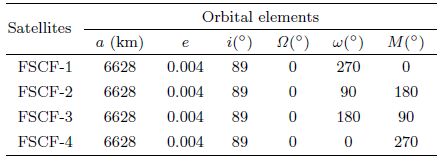2. College of Science, Wuhan University of Science and Technology, Wuhan 430081, China
Although the Earth’s medium-long-wavelength static and long-wavelength time-varying gravitational field can be precisely determined by the Gravity Recovery and Climate Experiment (GRACE) satellite gravity mission[1, 2, 3, 4, 5, 6, 7, 8, 9, 10, 11] relative to the traditional carborne,shipborne and airborne gravity measurement technologies,the inherent shortcomings of the twin GRACE satellites (firstly,the orbital altitude of the satellite can not be substantially reduced; secondly,the measurement accuracy of key payloads can not be further improved; thirdly,the vertical gravity gradient can not be efficiently obtained; finally,the aliasing effect of the highfrequency signals can not be precisely mitigated) are unable to be completely eliminated by self-regulation,but can depend on the successful implementation of the next-generation satellite gravity mission[12, 13, 14, 15, 16, 17, 18]. In order to effectively compensate for the defects of the twin GRACE satellites and accurately develop the next-generation Earth medium-short-wavelength static and medium-long-wavelength time-varying gravity field models with high spatial resolution,the American Jet Propulsion Laboratory (JPL) have brought forward the next-generation satellite gravity mission of the four-satellite cartwheel formation system as shown in Fig.1 and Table1[19].
| Table 1 A comparison of current GRACE-A/B and next-generation FSCF-1/2/3/4 satellite gravity missions[19] |
Massonnet[20] first applied the satellite cartwheel formation mode to the passive radar interferometry in 1998,and Sneeuw and Schaub[21] proposed a new idea of precisely detecting the Earth’s gravitational field by the four-satellite cartwheel formation mode in 2004. As illustrated in Fig.1 and Table1,the main idea of the four-satellite cartwheel formation system are as follows: firstly,each satellite flies along their elliptical orbits around the Earth; secondly,the center of mass of the four-satellite cartwheel formation system will move by a circular orbit around the Earth; thirdly,every satellite goes around the center of mass of the four-satellite cartwheel formation system by an elliptical orbit (semimajor ρmax: semiminor ρmin=2:1). The second-order derivatives of the Earth’s gravitational potential V (r,θ,λ) with respect to x,y,z are defined as

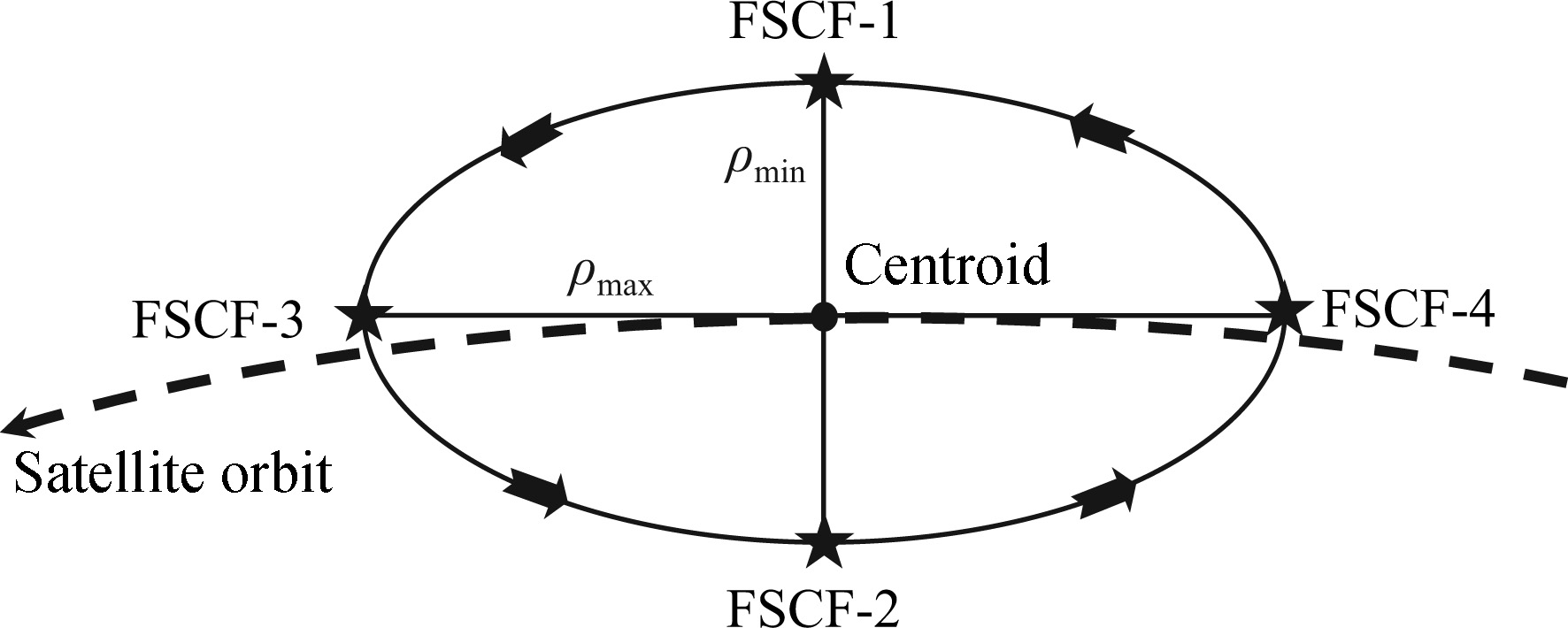
|
Fig.1 Schematic diagram of the next-generation four-satellite cartwheel formation (FSCF)[19] |
The optimal design of the satellite orbital elements is highly important for successfully developing the next-generation satellite gravity mission from the four-satellite cartwheel formation system. Ref.[22] brought forward that the initial argument of perigee ω should be set at the poles,and the initial mean anomaly must be designed at the equator in the next-generation four-satellite cartwheel formation system. Different from the above-mentioned study result,we newly carried out the studies on the stability design of the orbital elements from the four-satellite cartwheel formation system. The research results show that the next-generation foursatellite cartwheel formation system has a stability framework while the initial argument of perigee ω being set at the equator and the initial mean anomaly being designed at the poles.
2 OPTIMAL DESIGN OF ORBITAL ELEMENTSAs illustrated in Fig.1,the next-generation four-satellite cartwheel formation system can be developed by setting the six Keplerian orbital elements (orbital semimajor axis a,orbital eccentricity e,orbital inclination i,longitude of ascending node ,argument of perigee ω and mean anomaly M). The specific principles are as follows: firstly,a,e,i and are constant; secondly,ω and M of the FSCF-1/2 and FSCF-3/4 satellites have a difference of 180° (ω1 = ω2 + 180° and M1 = M2 + 180°); finally,the ratio of the semimajor and semiminor axes from the elliptical orbit of the next-generation four-satellite cartwheel formation system is designed as ρmax : ρmin = 2 : 1. Due to the combined effects of the asymmetry and heterogeneity of the Earth’s gravitational field and the Earth’s oblateness J2,the orbital stability of the next-generation four-satellite cartwheel formation system will undergo a dramatic and rapid drift. Although the stability of the overall formation system may be maintained by the spaceborne Attitude and Orbital Control System (AOCS) of each satellite,a lot of consumption of jet fuel will rapidly shorten the life of the next-generation four-satellite cartwheel formation system. Therefore,we know that the optimal design on the orbital elements for the next-generation four-satellite cartwheel formation system is greatly important for precisely establishing the high-degree Earth gravity field model with high spatial resolution.
We simulated,respectively,the orbits of the FSCF-1/2/3/4 satellites by the numerical integration formulas of the 9th-order Runge-Kutta linear single-step method associated with the 12th-order Adams-Cowell linear multi-step method using an orbital altitude of 250 km,an observation time of 30 days,a sampling interval of 10 s and a reference gravity model of EGM 2008,and the Keplerian orbital elements are listed in Table2. Fig.2a shows the intersatellite range of the FSCF-1/2 satellites from the next-generation four-satellite cartwheel formation system. The argument of perigee ω is set at the poles and the mean anomaly M is set at the equator (Fig.2b),Fig.3a illustrates the intersatellite range of the FSCF-3/4 satellites,and the argument of perigee ω is set at the equator and the mean anomaly M is set at the poles (Fig.3b). By a comparison of Figs. 2a and 3a,setting the argument of perigee ω at the equator and the mean anomaly M at the poles can efficiently suppress a drift of the next-generation four-satellite cartwheel formation system and further guarantee the stability and precision of the Earth’s gravitational field measurement.
| Table 2 Optimal design of orbital elements in the next-generation four-satellite cartwheel formation |

|
Fig.2 (a) Intersatellite range of FSCF-1/2 in the next-generation four-satellite cartwheel formation; (b) Argument of perigee and mean anomaly of the FSCF-1/2 satellites |
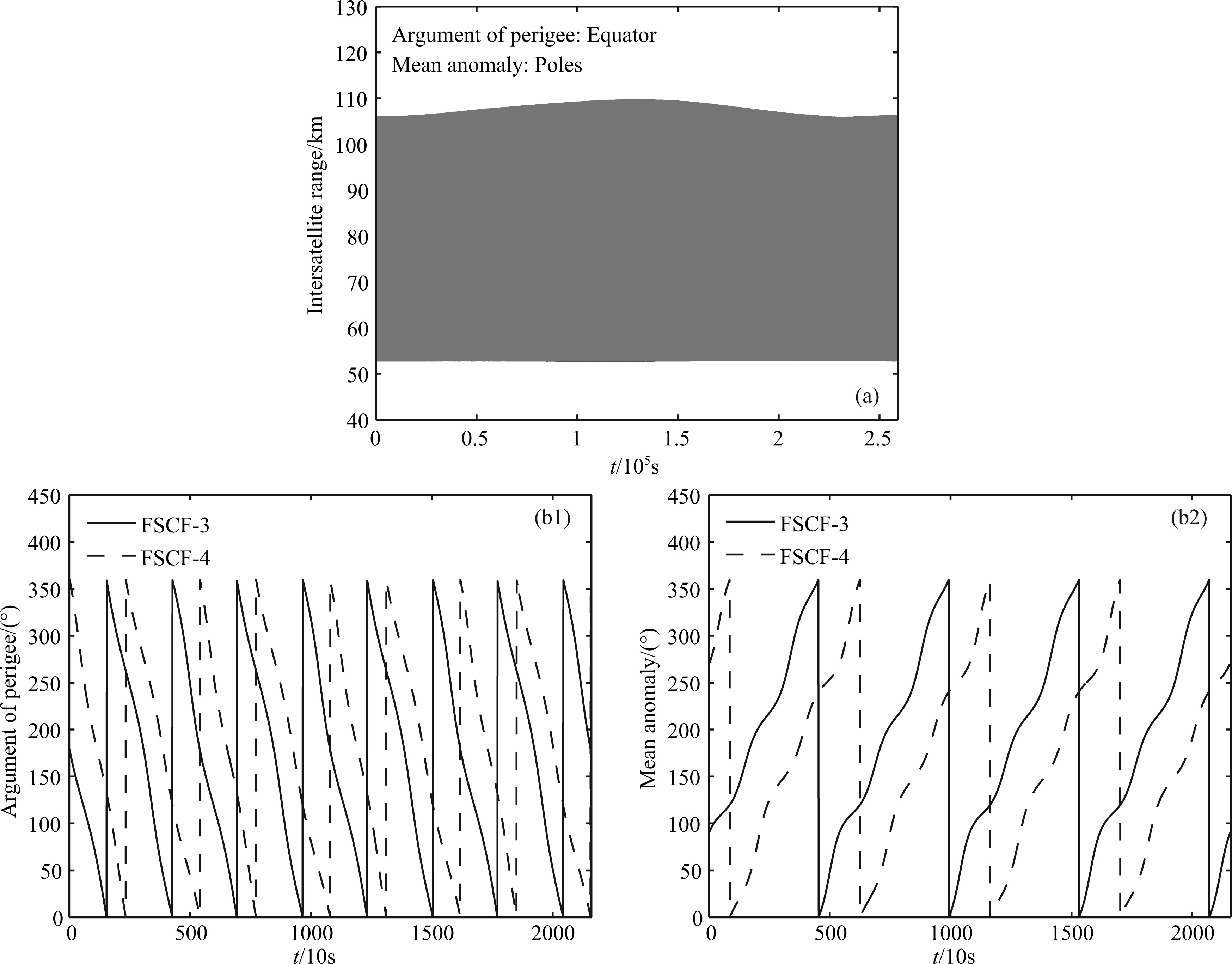
|
Fig.3 (a) Intersatellite range of FSCF-3/4 in the next-generation four-satellite cartwheel formation; (b) Argument of perigee and mean anomaly of the FSCF-3/4 satellites |
By the Gauss-Markov model,the colored noise expressions of satellite observations can be shown as[23]

Figure4 denotes,respectively,the colored noises of intersatellite range-rate,orbital position,orbital velocity and non-conservative force using correlation coefficients (0.85 in intersatellite range-rate of the interferometric laser ranging system,0.95 in orbital position and velocity of the GPS receiver,and 0.90 in non-conservative force of the spaceborne accelerometer)[24] and a sampling interval of 10 s by the Gauss-Markov colored noise model,and the statistical results are listed in Table3.
| Table 3 Statistics of colored noises from satellite observations |
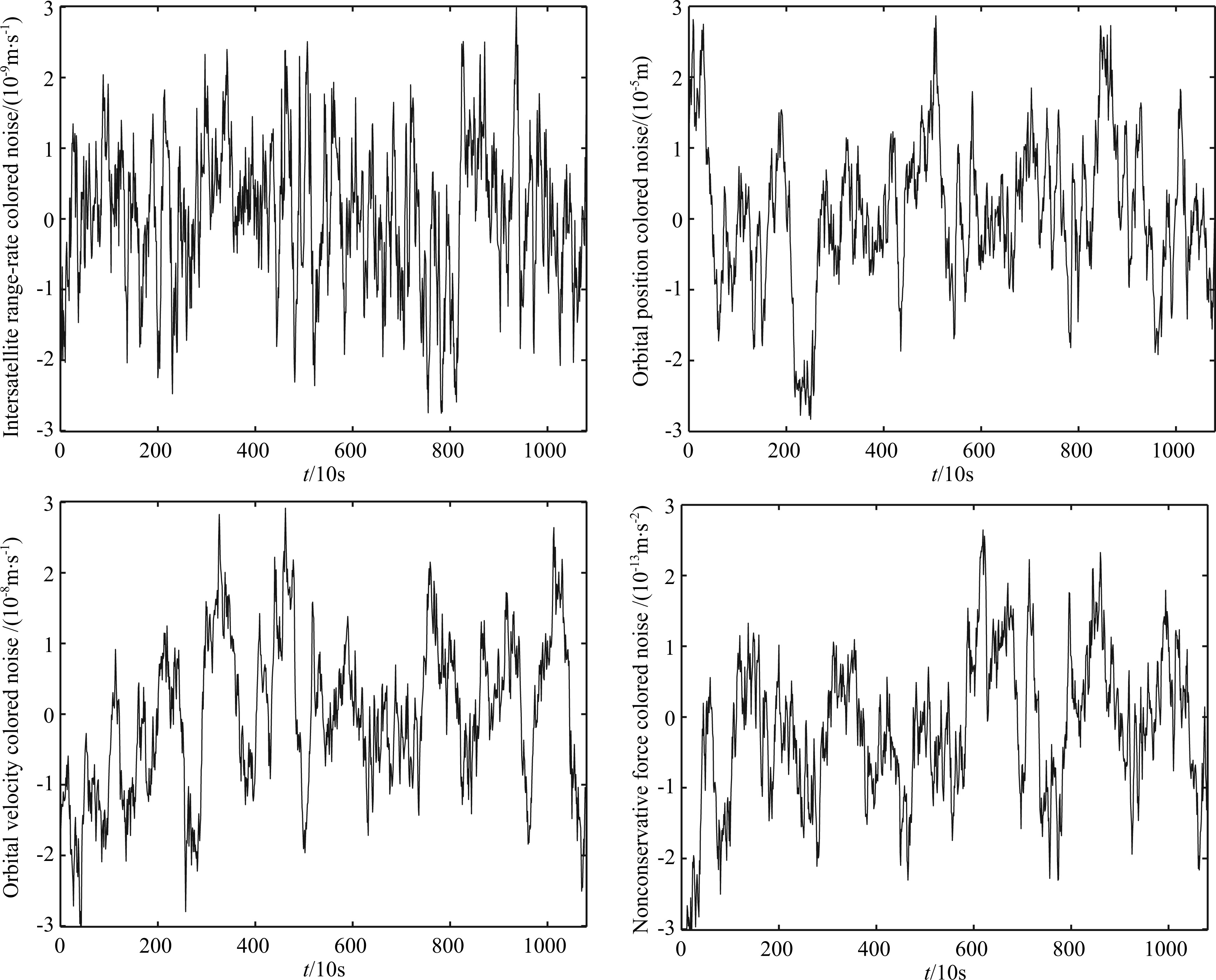
|
Fig.4 Colored noises of intersatellite range-rate,orbital position,orbital velocity and non-conservative force |
As illustrated in Fig.5,the dashed line displays the real accuracy of the Earth gravity field model EIGENGRACE02S complete up to degree and order 120 released by the GeoForschungsZenturmPotsdam (GFZ) in Germany,the cumulative geoid height error is 1.894×10-1 m at degree 120. The asterisk and solid lines represent the simulated accuracies of the Earth’s gravitational field recovery from GRACE-II and FSCF-1/2/3/4 based on the next-generation two-satellite collinear formation system and the four-satellite cartwheel formation system,intersatellite range-rate interpolation method[25],correlation coefficients (0.85 in intersatellite range-rate of the interferometric laser ranging system,0.95 in orbital position and velocity of the GPS receiver,and 0.90 in non-conservative force of the spaceborne accelerometer),an observation time of 30 days and a sampling interval of 10 s. At degree 120,cumulative geoid height errors from GRACE-II and FSCF-1/2/3/4 are 4.785×10-4 m and 1.162×10-4 m,respectively,and the statistical results are listed in Table4. The research results show: Firstly,the next-generation FSCF-1/2/3/4 four-satellite cartwheel formation system can additionally measure the vertical gravity gradient signals relative to the next-generation GRACE-II two-satellite collinear formation system. Therefore,the measurement accuracy of the Earth’s medium-long-wavelength gravitational field is substantially improved. At degree 120,the accuracy of the Earth’s gravitational field recovery from the next-generation FSCF-1/2/3/4 four-satellite cartwheel formation system is four times higher than that from the next-generation GRACE-II two-satellite collinear formation system. Secondly,the cumulative geoid height error from the next-generation FSCF-1/2/3/4 four-satellite cartwheel formation is at least one order of magnitude lower than that from the current GRACE satellite.
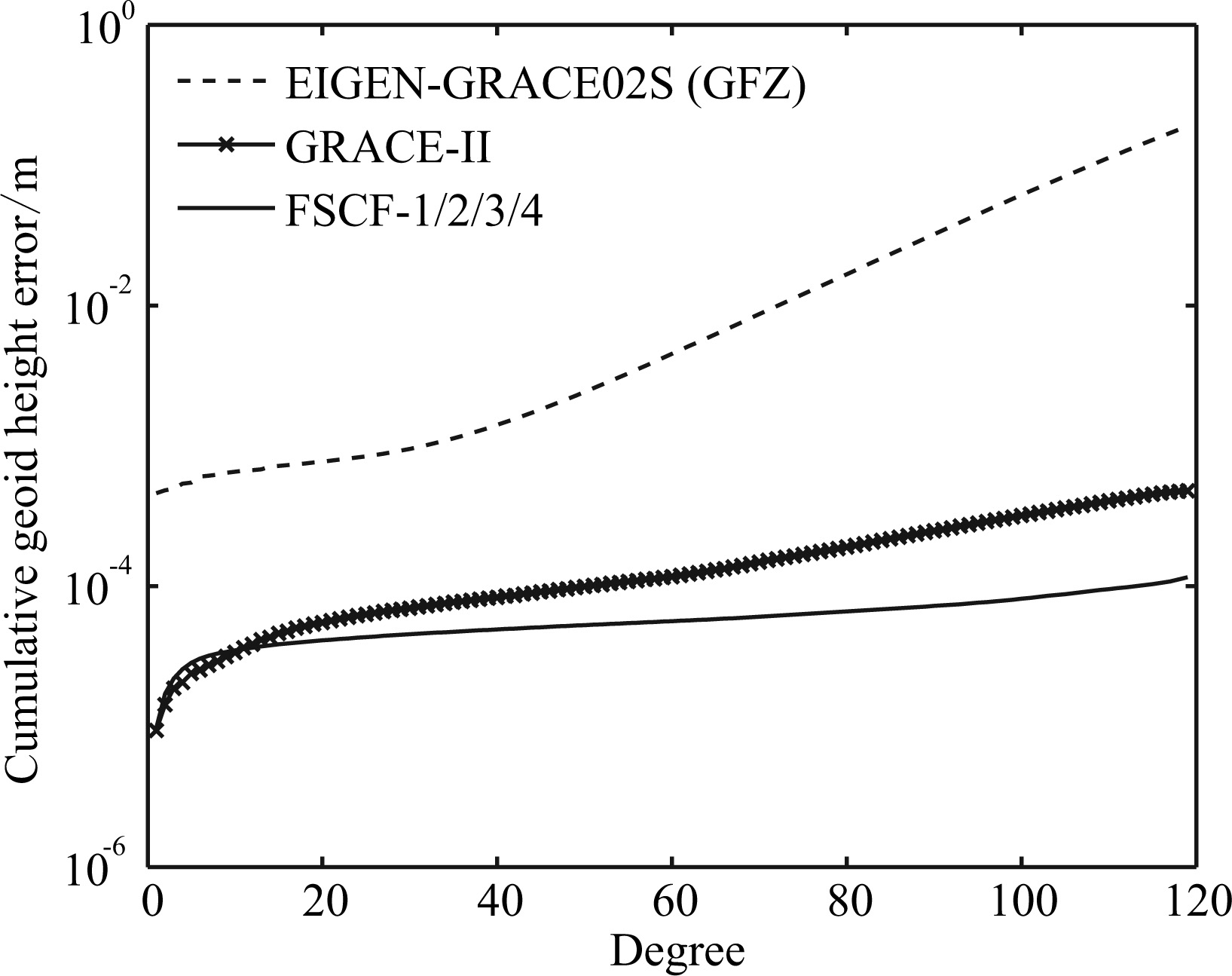
|
Fig.5 Cumulative geoid height errors based on the next-generation four-satellite cartwheel formation |
| Table 4 Statistical results of cumulative geoid height errors |
(1) The satellite orbital altitude can be highly reduced. The GRACE twin-satellite collinear formation system real-timely measures the in-orbit nonconservative force by the spaceborne accelerometer,and deducts the non-conservative force effects in the post processing of data. Therefore,due to the negative interference of the non-conservative force,the orbital altitude (500 km) of the twin GRACE satellites can not be substantially decreased. The domestic and foreign studies have shown that if an satellite orbital altitude is reduced by 100 km,the non-conservative forces acting on the gravity satellite will have an increase of about 10 times[26]. In order to substantially provide the quiet and stable measurement environment for the key payload of the gravity satellite and extend the lifetime of the satellite as much as possible by efficiently shielding the non-conservative forces,the next-generation four-satellite cartwheel formation system plans to carry the Drag-Free Control System (DFCS). Therefore,the satellite orbital altitude (~250 km) can be highly decreased in the next-generation four-satellite cartwheel formation system,and the signal exponential attenuation effects of the Earth’s gravitational field determination with the increase of the orbital altitude can be restrained efficiently.
(2) The measurement accuracy of key payloads can be greatly improved. The GRACE twin-satellite collinear formation system measures the intersatellite range with an accuracy of 10 μm and the intersatellite range-rate with a precision of 1 μm/s by the K-Band Ranging (KBR) system and determines the nonconservative force with a resolution of 10-10 m/s2 by the accelerometer. For the sake of decreasing the negative error impacts of the key payloads on the accuracy of the Earth’s gravitational field,the next-generation foursatellite cartwheel formation system will ultra-precisely determine a intersatellite range with an accuracy of 10 nm and a intersatellite range-rate with a precision of 1 nm/s by the Interferometric Laser Ranging (ILR) system,and high accurately compensate the non-conservative forces with a resolution of 10-13 m/s2 acting on the satellite by the Drag-Free Control System. The measurement accuracy of the key payloads in the nextgeneration four-satellite cartwheel formation system can be highly improved,therefore,the accuracy of the Earth gravity field model based on the next-generation four-satellite cartwheel formation system is at least one order of magnitude higher than that based on the GRACE twin-satellite collinear formation system.
(3) The three-dimensional gravity gradients can be simultaneously obtained. Because the GRACE twinsatellite collinear formation system is equivalent to a horizontal gravity gradiometer with a baseline length of intersatellite range 220 km,GRACE can not obtain the vertical signals of the gravity gradients and the accuracy of the Earth’s gravitational field will be highly lost. Because the horizontal and vertical signals of the gravity gradients can be precisely determined by the next-generation four-satellite cartwheel formation system,not only the accuracy of the Earth’s gravitational field is highly improved,but also the longitudinal strip errors of the Earth’s time-varying gravity field caused by a signal lack of the vertical gravity gradients can be precisely weakened.
(4) The aliasing effects of the high-frequency signals can be efficiently mitigated. The aliasing effect of the high-frequency errors,including the non-tidal atmospheric and oceanic mass changes,etc.,is an important factor for losing the accuracy of the Earth’s gravitational field recovery from GRACE[27, 28]. Because the highfrequency errors of the non-tidal atmospheric and oceanic mass changes are close to the computational model errors,the high-frequency errors can not be precisely deducted from the GRACE Earth gravity field model. The next-generation four-satellite cartwheel formation system can not only measure the horizontal gravity gradients similar to the GRACE twin-satellite collinear formation system,but also obtain the vertical signals of the gravity gradient in order to decrease the negative interferences of the aliasing effects of the high-frequency signals on the accuracy of the Earth’s gravitational field recovery.
(5) The medium-long-wavelength signals of the Earth’s time-varying gravitational field can be precisely detected. The GRACE twin-satellite collinear formation system can measure the long-wavelength signals of the Earth’s time-variable gravitational field with a spatial resolution of about 400 km,but can not precisely determine the medium-long-wavelength signals of the Earth’s time-varying gravitational field with a spatial resolution of better than 200 km. The next-generation four-satellite cartwheel formation system will highly improved the measurement accuracy of the medium-long-wavelength signals of the Earth’s time-varying gravitational field by the interferometric laser ranging system and the drag-free control system and aim to provide important information of the precise Earth’s time-varying gravitational field with high spatial resolution for the cross-over studies including seismology,oceanography,glaciology,hydrology,national defense,etc.
5 CONCLUSIONS(1) Different from previous study results,we proposed that it is preferable for setting the initial argument of perigee ω at the equator and the initial mean anomaly at the poles to efficiently suppress the drift of the next-generation four-satellite cartwheel formation system.
(2) We recovered precisely and rapidly the next-generation FSCF Earth’s gravitational field complete up to degree and order 120 by the intersatellite range-rate interpolation method. The accuracy of the Earth’s gravitational field from FSCF is at least one order of magnitude higher than that from GRACE. Therefore,the correctness of the orbital elements from the next-generation four-satellite cartwheel formation system designed in this paper is validated.
(3) The four-satellite cartwheel formation system is an optimal project for accurately developing the nextgeneration Earth gravity field model with high spatial resolution based on the strongpoints of the lower satellite orbital altitude,the higher measurement accuracy of key payloads,the full-tensor gravity gradient measurement,the weak aliasing effects of high-frequency signals,and the precise medium-long-wavelength signals of the Earth’s time-varying gravitational field.
ACKNOWLEDGMENTSWe greatly appreciate the helpful suggestions from anonymous referees and editors,and Prof. Jun Luo,School of Physics,Huazhong University of Science and Technology,China. This work was supported by the Main Direction Program of Knowledge Innovation of Chinese Academy of Sciences for Distinguished Young Scholar under Grant No. KZCX2-EW-QN114,the National Natural Science Foundation of China under Grant Nos. 41004006,41202094,41131067 and 11173049,the Merit-based Scientific Research Foundation of the State Ministry of Human Resources and Social Security of China for Returned Overseas Chinese Scholars under Grant No. 2011,the Open Research Fund Program of the Key Laboratory of Geospace Environment and Geodesy,Ministry of Education,China under Grant No. 11-01-02,the Open Research Fund Program of the Key Laboratory of Geo-Informatics of National Administration of Surveying,Mapping and Geoinformation of China under Grant No. 201322,and the Open Research Fund Program of the State Key Laboratory of Geo-information Engineering under Grant No. SKLGIE2013-M-1-5.
| [1] Xu H Z. Satellite gravity missions-new hotpoint in geodesy. Science of Surveying and Mapping (in Chinese), 2001, 26(3): 1-3. |
| [2] Ning J S. The satellite gravity surveying technology and research of Earth's gravity field. Journal of Geodesy and Geodynamics (in Chinese), 2002, 22(1): 1-5. |
| [3] Zhang H W, Xu H Z, Liu X Q. Basic theory and numerical result of the Love number of solid Earth tide. Progress in Geophysics (in Chinese), 2004, 19(2): 372-378. |
| [4] Shen Y Z, Xu H Z, Wu B. Simulation of recovery of the geopotential model based on intersatellite acceleration data in the low-low satellite to satellite tracking gravity mission. Chinese J. Geophys. (in Chinese), 2005, 48(4): 807-811. |
| [5] Cheng L Y, Xu H Z. The rotation of the gravity potential on the Earth's gravity field recovery. Chinese J. Geophys. (in Chinese), 2006, 49(1): 93-98. |
| [6] Zhou X H, Xu H Z, Wu B, et al. Earth's gravity field derived from GRACE satellite tracking data. Chinese J. Geophys. (in Chinese), 2006, 49(3): 718-723. |
| [7] Zheng W, Shao C G, Luo J, et al. Numerical simulation of Earth's gravitational field recovery from SST based on the energy conservation principle. Chinese J. Geophys. (in Chinese), 2006, 49(3): 712-717. |
| [8] Xu P L. Position and velocity perturbations for the determination of geopotential from space geodetic measurements. Celestial Mechanics and Dynamical Astronomy, 2008, 100(3): 231-249. |
| [9] Zheng W, Xu H Z, Zhong M, et al. Efficient and rapid estimation of the accuracy of GRACE global gravitational field using the semi-analytical method. Chinese J. Geophys. (in Chinese), 2008, 51(6): 1704-1710. |
| [10] Zheng W, Xu H Z, Zhong M, et al. Effective processing of measured data from GRACE key payloads and accurate determination of Earth's gravitational field. Chinese J. Geophys. (in Chinese), 2009, 52(8): 1966-1975. |
| [11] Zheng W, Xu H Z, Zhong M, et al. Efficient accuracy improvement of GRACE global gravitational field recovery using a new inter-satellite range interpolation method. Journal of Geodynamics, 2012, 53: 1-7. |
| [12] Sneeuw N. Science requirements on future missions and simulated mission scenarios. Earth, Moon, and Planets, 2005, 94(1): 113-142. |
| [13] Bender P L, Wiese D N, Nerem R S. A possible dual-GRACE mission with 90 degree and 63 degree inclination orbits.//Proceedings of the Third International Symposium on Formation Flying, Missions and Technologies. ESA/ESTEC, Noordwijk, 2008: 1-6. |
| [14] Zheng W, Shao C G, Luo J, et al. Improving the accuracy of GRACE Earth's gravitational field using the combination of different inclinations. Progress in Natural Science, 2008, 18(5): 555-561. |
| [15] Zheng W, Xu H Z, Zhong M, et al. Physical explanation of influence of twin and three satellites formation mode on the accuracy of Earth's gravitational field. Chinese Physics Letters, 2009, 26(2): 029101-1-029101-4. |
| [16] Zheng W, Xu H Z, Zhong M, et al. Efficient and rapid estimation of the accuracy of future GRACE Follow-On Earth's gravitational field using the analytic method. Chinese J. Geophys. (in Chinese), 2010, 53(4): 796-806. |
| [17] Wiese D N, Nerem R S, Lemoine F G. Design considerations for a dedicated gravity recovery satellite mission consisting of two pairs of satellites. Journal of Geodesy, 2012, 86: 81-98. |
| [18] Loomis B D, Nerem R S, Luthcke S B. Simulation study of a follow-on gravity mission to GRACE. Journal of Geodesy, 2012, 86(5): 319-335. |
| [19] Wiese D N, Folkner W M, Nerem R S. Alternative mission architectures for a gravity recovery satellite Mission. Journal of Geodesy, 2009, 83(6): 569-581. |
| [20] Massonnet D. Roue interfrometrique. French patent no 339920D17306RS, 1998. |
| [21] Sneeuw N, Schaub H. Satellite clusters for future gravity field missions. IAG International Symposium, Gravity, Geoid and Space Missions, 2004, Porto, Portugal. 2005: 12-17. |
| [22] Wiese D N. Alternative mission architectures for a gravity recovery satellite mission[Master's thesis]. Boulder: University of Colorado, 2007: 1-73. |
| [23] Reubelt T, Austen G, Grafarend E W. Harmonic analysis of the Earth's gravitational field by means of semicontinuous ephemeris of a low Earth orbiting GPS-tracked satellite, Case study: CHAMP. Journal of Geodesy, 2003, 77(5-6): 257-278. |
| [24] Zheng W, Xu H Z, Zhong M, et al. Impacts of interpolation formula, correlation coefficient and sampling interval on the accuracy of GRACE Follow-On intersatellite range-acceleration. Chinese J. Geophys. (in Chinese), 2012, 55(3): 822-832. |
| [25] Zheng W, Xu H Z, Zhong M, et al. Precise recovery of the Earth's gravitational field with GRACE: Intersatellite Range-Rate Interpolation Approach. IEEE Geoscience and Remote Sensing Letters, 2012, 9(3): 422-426. |
| [26] Zheng W, Xu H Z, Zhong M, et al. Optimal design of orbital altitude in satellite-to-satellite tracking model. Journal of Geodesy and Geodynamics (in Chinese), 2009, 29(2): 100-105. |
| [27] Han S C, Jekeli C, Shum C K. Time-variable aliasing effects of ocean tides, atmosphere, and continental water mass on monthly mean GRACE gravity field. Journal of Geophysical Research, 2004, 109: B04403. |
| [28] Seo K W, Wilson C R, Chen J, et al. GRACE's spatial aliasing error. Geophysical Journal International, 2008, 172: 41-48. |
 2013, Vol. 56
2013, Vol. 56


